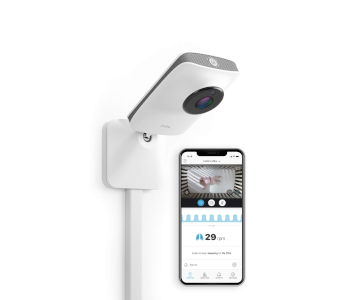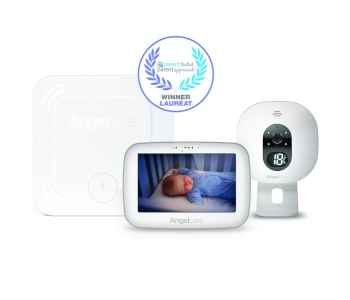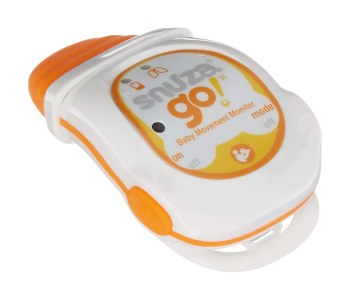Every new parent experiences some level of fear and uncertainty when it comes to bringing your little one home. There are so many things to keep track of when you have a new baby in the house, from clean feeding utensils to making sure your baby’s nursery is safe.
Breathing monitors can help give you back peace of mind, no matter how young your baby is. Breathing monitors help prevent SIDS, sudden infant death syndrome, one of the biggest fears of most new parents. A good breathing monitor can also help you tell when your baby is upset, needs your attention, or even if they’re starting to catch a cold.
For such an important job, you don’t want to trust just any monitor. You need to know that your little one is well protected by whatever system you use. Unfortunately, there is no one perfect solution. The best monitor depends a lot on your family and personal preferences.
However, there are several baby breathing monitors that stand out from the crowd in terms of their features, effectiveness, and ease of use. We’ve chosen some of the best monitors from that group and will go over the pros and cons of each model.
Since this is a critical decision for your own peace of mind as well as the health and safety of your little one, we’ll also provide a short buying guide to help you make an informed choice.
Lastly, we’ve chosen from a range of prices and system complexity. We believe that all parents deserve extra peace of mind and security for their little one and that that extra security shouldn’t break the bank. You’ll find affordable options as well as premium choices in this list.
| Bargain |
|---|
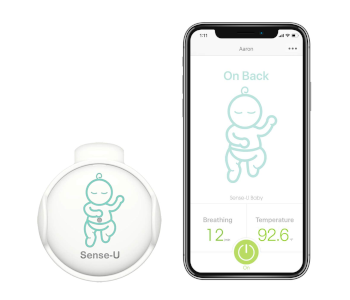 |
| Sense-U Baby Monitor |
| 4.6/5.0 |
| Check Amazon |
| Best Value |
|---|
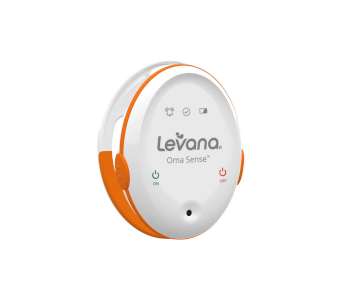 |
| Levana Oma Sense Portable Breathing Movement Monitor |
| 4.7/5.0 |
| Check Amazon |
| Top Pick |
|---|
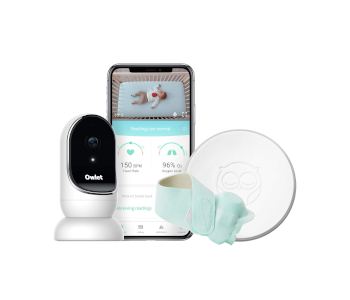 |
| Owlet Smart Baby Monitor Duo |
| 4.8/5.0 |
| Check Amazon |
Quick Comparison:
We can’t fit all the important information about baby breathing monitors on a small table. But, these comparisons can still help you narrow your list to only a couple of the best options.
Read on to learn more about each model or skip to the bottom to see our buying guide to help make an informed decision.
| The Breathing Monitors | Camera | Wearable Monitor |
Wifi Enabled? |
Check the Price |
|---|---|---|---|---|
| Owlet Smart Baby Monitor Duo | Yes | Yes | Yes | Check the Price |
| Sense-U Baby Monitor | No | Yes | Bluetooth | Check the Price |
| Levana Oma Sense Portable Breathing Movement Monitor | No | Yes | No | Check the Price |
| Miku Smart Baby Monitor | Yes | No | Yes, with some routers | Check the Price |
| Angelcare 3-in-1 Baby Monitor | Yes | Under Mattress Monitor | Yes | Check the Price |
| Babysense Video & Baby Movement Monitor | Yes | Under Mattress Monitor | Yes | Check the Price |
| Snuza Go! Wireless Baby Monitor | No | Yes | No | Check the Price |
The Breathing Monitors:
1. Owlet Smart Baby Monitor Duo – Top Pick
Editor’s Rating: 4.8
A slightly less expensive price tag and a slightly larger connectivity rage for the base would have netted this monitoring system a perfect score (5). As is, this is a good option for families that can afford it, and don’t mind spending a little extra time on setup, but it isn’t perfect.
This monitoring system is a complete package with both camera and a wearable monitor. It’s more expensive than some systems, but that’s because the Owlet also monitors more details than most monitoring systems.
You’ll have a good day/night camera with an HD video feed, along with a small wearable sock that transmits information about your baby’s heart rate and oxygen levels directly to your smartphone. The system comes with three washable socks, so you can switch to a larger sock as your baby grows.
The camera transmits color video in light and grayscale video at night. You’ll also have the option of tuning in to a 2-way audio feed. That’s perfect for parents that are always on the go. You can take a moment to tune in to hear your baby’s peaceful breathing or spend a couple of minutes talking through the 2-way audio to help soothe a fussy sleeper.
In addition, you’ll also get a lot of detailed information about the quality and quantity of sleep your baby gets. The Owlet monitors how long it takes for your baby to fall asleep, and also monitors signs of them going through the different stages of sleep.
That makes it a great choice for parents who want to stay on top of how their baby does with new nursery environments or changes to their normal bedtime routine.
The biggest downside with this monitor is that large babies might outgrow the monitoring system a little early. It’s also an expensive appliance if you’re only planning on having one child since it’s only useful for about the first 18 months of life (though you can certainly use the camera longer).
| Pros |
|---|
| Monitors heart rate and O2 levels |
| Monitors baby’s breathing |
| Gives you a 2-way audio connection when you’re away |
| Works with a wide range of mobile devices |
| Provides more detailed health information than most monitors |
| Cons |
|---|
| Setting up the connectivity base can be tricky, especially in large nurseries |
| Video feed does not support windowed use on your phone |
| The system is rather expensive |
| Specs |
|---|
| Comes with 3 socks |
| Camera included |
| Connectivity base |
| Free app works on most phones and carriers |
| Wifi-enabled |
2. Sense-U Baby Monitor – Best Bargain
Editor’s Rating: 4.6
The Sense-U is a different style of monitoring system and is a little easier to use that dual monitoring systems like the Owlet. The Sense-U is a wearable, a small button-like attachment that you just clip to your baby’s diaper.
The nice thing about this particular monitor is that it’s small, smooth, and less noticeable than many similar monitors. While we’ve included one monitor that’s a larger wearable, the Snuza Go, this one got best bargain for being the more comfortable and least obtrusive of the two (they’re similarly priced).
The system uses Bluetooth connectivity with a 50 ft radius to monitor your little one. That’s the biggest downside to this system, it doesn’t have wifi connectivity, which means that the monitor only works when you have a connected smartphone in range.
In-home firewalls can also make it difficult to connect, even inside the 50 ft range, so you may want to think carefully before buying this device if you have firewalls installed.
That said, this monitoring system has one of the better alert systems out there. It monitors for breathing movements and can tell you how many movements your baby is making per minute. Babies breathing can be notoriously irregular, so this system helps you tell if your little one is holding their breath for a few seconds at a time, or if they are breathing more slowly than usual.
You’ll also get a temperature read, which will help you know sooner if your little one is too cold or spikes a fever.
Lastly, the Sense-U will send an immediate alert if your baby rolls onto their stomach. That’s a useful tool during the couple month transition when your little one is starting to move and wiggle in their crib but isn’t ready to sleep on their stomach safely.
| Pros |
|---|
| Several useful alerts |
| Easy to use |
| Bluetooth works with most modern smartphones |
| App provides helpful real-time temp and position information |
| Doesn’t require much initial setup |
| Lightweight |
| Smooth small design |
| Cons |
|---|
| Only has a 50 ft range |
| Requires watch batteries to operate |
| No visual information |
| Specs |
|---|
| Monitors baby’s temperature |
| Rollover alerts |
| Breath monitoring |
| Fits on fabric 2mm or less in thickness |
| Needs to be placed near your baby’s belly button |
3. Levana Oma Sense Portable Breathing Movement Monitor – Best Value
Editor’s Rating: 4.7
The Levana Oma sensor is similar to the Sense-U in that it’s a small, oval, wearable sensor that you’ll clip to your baby’s clothing near their belly button.
However, the Levana Oma goes a little further than most monitoring devices, producing vibration and sounds when it detects a problem to help encourage your baby to start breathing more normally.
It’s also a little different in that the Levana Oma doesn’t use Wifi, radio, or Bluetooth communication frequencies. That means it’s harder to check on your little one when you’re in another room or away from home, but also means that there is less that could go wrong with the monitor itself.
Checking on your little one is simple with this monitor. It doesn’t require skin contact, so you’ll be able to see both the power indicator and a small flashing blue light that indicates all is well. Brighter flashing lights, vibration, and noises will alert you if there’s any problem.
However, this monitor isn’t a good option for parents who want to use a rocking bassinet or anything that adds additional movement to your baby’s bassinet or crib. The system primarily monitors for movement, so those additional movements may mask a breathing problem and fool the monitor into not alerting.
| Pros |
|---|
| Easy to operate |
| Alerts can help baby breathe normally while you come to help |
| Easy to check on your little one |
| Doesn’t need skin contact |
| Easy to turn on and off |
| Cons |
|---|
| No smartphone connectivity |
| Cannot be used with any additional source of motion |
| No long-distance monitoring options |
| Specs |
|---|
| 3.60 x 7.80 x 5.80 inches |
| 8.8 oz total |
| Lithium batteries required |
| No skin contact |
4. Miku Smart Baby Monitor
Editor’s Rating: 4.7
This system is a little different again. Instead of offering a wearable and a camera, it’s just a camera system. The high-detail video feed monitors for breathing and movement, as well as monitoring the temperature and humidity in your baby’s nursery.
Miku should be positioned directly above your little one’s sleep area for the best picture and clearest idea of what’s happening with your baby. The system also comes with a dual speaker system that can play lullabies and other soothing sounds to help your baby fall asleep and stay asleep.
The system is also incredibly secure, with everything encrypted so that your video feed is always safe.
However, there are a couple of downsides with the system. While you get top of the line monitoring, it also comes with top of the line pricing. You’ll also have to check and make sure your router is compatible with the Miku system since wifi compatibility isn’t 100% universal with this camera.
That said, the sound and video monitoring are an important way to get additional peace of mind while your baby sleeps. This system has also won several consumer awards for superior design and operation.
| Pros |
|---|
| HD video and audio connection to your little one |
| Wifi-enabled for better connection anywhere |
| Fully encrypted video feed |
| Relatively simple set up |
| No skin contact |
| Also measures room temperature and humidity |
| Cons |
|---|
| This system is pricey |
| No wearable for closer monitoring |
| No distance monitoring when wifi goes down |
| Specs |
|---|
| Comes with camera and dual speaker system |
| Wifi-enabled (with some routers) |
| 256-bit encryption |
| Offers sleep analytics |
| Temperature monitoring (room) |
| Humidity monitoring |
5. Angelcare 3-in-1 Baby Monitor
Editor’s Rating: 4.5
This system is a more affordable 3 in 1 camera monitoring system. Its built-in alert will sound if your little one doesn’t move for 20 seconds. That’s long enough to make sure it’s not a false alarm from your little one holding their breath, but short enough to make sure you can get to your baby quickly if there’s a problem.
The camera also monitors room temperature, all while supplying a constant video and audio feed of your little one.
The wifi enabled system works with most routers, using the 2.4ghz connection band.
However, this system primarily works with a small LCD screen, with the option of adding up to 2 additional screens if needed. That means you have less smartphone connectivity, but a slightly more reliable connection to the screen itself.
| Pros |
|---|
| Comes with a portable baby-monitoring screen |
| Monitors temperature |
| Less likely to false alarm than many systems |
| No electronics touching your baby’s skin |
| Can add additional cameras and screens (up to 2 more each) |
| Cons |
|---|
| Max range 820 ft, no out of home monitoring |
| No smartphone connectivity |
| Doesn’t measure baby temperature, heart rate, or o2 levels |
| Specs |
|---|
| Comes with camera, microphone, and LCD screen |
| 2.4ghz connection |
| 820 ft range |
| Can add up to 2 cameras |
| Can add up to 2 additional screens |
6. Babysense Video & Baby Movement Monitor
Editor’s Rating: 4.6
This unit is different again, partially because it’s one of the first no-touch monitors that was ever produced. You’ll get a camera, a small parent unit with a screen and some control options, and an under-mattress movement monitor.
That combination makes this system very complete, like the Owlet, but without requiring a wearable monitor.
However, it has a similar weakness in that you can’t use a moving bassinet or crib with this system.
It’s also in-home only, without an app or smartphone connectivity to provide out of home monitoring solutions.
The system will alert if it detects no movement for 20 seconds, or less than 10 micro-movements per minute, both signs that your little one is in trouble. But, since the system uses both video and movement monitoring, you’ll be able to quickly identify the problem.
Overall, this is one of the better options out there, but it’s a little more difficult to set up, and not as well suited to parents who are constantly on the go. Otherwise, this system might have netted our top pick designation.
| Pros |
|---|
| Combination monitoring gives you more peace of mind |
| Parent unit is easy to use |
| System is largely stable once it’s set up |
| Additional monitoring of temperature |
| Works quickly to alert you to possible trouble |
| Cons |
|---|
| Install can be more difficult |
| Need to replace batteries in the movement monitor |
| Display is very small |
| Specs |
|---|
| 2.4 in display |
| Camera, parent unit, and movement monitor included |
| 900 ft range |
| 2.4ghz connection |
7. Snuza Go! Wireless Baby Monitor
Editor’s Rating: 4.3
The last monitoring system on our list, the Snuza Go almost made our best bargain rating. It’s an affordable option for most families and provides added peace of mind. However, despite being slightly cheaper than our best bargain pick, it’s also slightly larger and may be more uncomfortable for your little one to wear.
That said, the total design is still small. In addition to the monitor itself, you’ll also have a small carrying case for travel and storage. That way you can keep the monitor safe anytime it isn’t in use, and it’s a good option for families that are frequently on the go.
There are three different alarm sounds you can choose from, but there aren’t any remote monitoring options with this system.
It also alerts on a slightly more delayed basis than many monitors, waiting for less than 8 movements per minute instead of the more standard less than 10 movements.
The batteries on this monitor last an average of six months, and it’s a useful tool for about the first 18 months of your child’s life, so you should expect to go through approximately three sets of batteries.
| Pros |
|---|
| Easy to use |
| Several alarm options |
| Long-lasting battery |
| Travel friendly |
| Good secondary monitoring system when you aren’t at home |
| Affordable option |
| Cons |
|---|
| Alerts more slowly than some monitors |
| Slightly larger than other clip-on monitoring options |
| Specs |
|---|
| 4 stage light alert system |
| Audible alert with three alarm choices |
| Comes with battery included |
Buying Guide:
These are some of the most important features for any breathing monitor system. This isn’t a complete guide, but it will help you decide on a monitor that’s more likely to work for you and your family.
Pros and Cons of Wifi Enabled Monitors
Wifi-enabled systems are increasingly popular today. Wifi can make it easier to connect your monitoring system to your smartphone, which adds a lot of convenience.
But, wifi-enabled systems need a backup option if you want to have monitoring options when your internet goes down. Internet outages are inevitable, so you may want to consider whether your monitor will continue to function without it.
Wifi also has some disadvantages, including that relatively few in-home wifi systems in the United States can handle streaming real-time HD video from a camera. You’ll likely either have some delays or will have to reduce video quality to get a continuous stream.
The last concern is data on your phone plan. If you intend to use your monitoring system to keep track while your little one is looked after by a friend or family member, you’ll probably run up your data bill streaming information.
If you have a stable wifi connection, you won’t have to worry about data. But only a few hours of streaming through 3G or 4G can eat several gigs of your data plan.
Wearables?
A lot of breathing monitors come with a small device designed to be worn by your baby. Some of the most common clip on to their diaper, but there are several different designs.
Wearables can give you some of the most immediate and reliable feedback, but they can also be uncomfortable for your little one. The wrong wearable might make it harder for your baby to go to sleep and stay asleep.
Some parents are also concerned about wifi and other connection signals coming that close to their baby. While all these devices are safe, it’s worth considering what kind of device will work best for your family.
Wearables are consistent, fast, and can also have adaptations that allow them to encourage breathing and alert parents when something is wrong. But they aren’t right for everyone.
Camera Systems
Cameras are some of the most popular options. They were also one of the first things to get added to baby monitoring systems, back when the most common baby monitors were just a walkie-talkie or radio system listening for crying.
As cameras have gotten more advanced, they’ve gotten better at monitoring for details like breathing and sleep disturbance.
But cameras tend to be more reliant on Wi-Fi, and you need good encryption to make sure no one is tapping into your video feed from outside the home. Always look for encryption protection when you buy a nursery camera.
Dual Monitor Systems
By dual monitor, we mean systems that incorporate two or more means of monitoring your baby. The most common of these combine a camera with a wearable monitor or an under-mattress monitor so you have more real-time data.
These systems tend to be some of the most reliable and trustworthy. However, they are also more expensive and can be more difficult to set up.
If you aren’t reasonably technically adept, you may want to skip a dual monitor system and choose either a camera or a wearable system.
Reliability
One of the things parents are always concerned about is the reliability of their monitoring devices. The truth is that almost all consumer monitoring devices are highly reliable, but that none of them are hospital grade-devices.
Basically, a breathing monitoring system is a good way to have added peace of mind and can help you keep an eye on your little one while they sleep. But, they aren’t a replacement for a safe sleeping environment, proper positioning, and other safety precautions for your little one.
If you have any concerns about the data you collect from your baby monitor, you should consult with your pediatrician.

